
Journal of Central Banking Theory and Practice
Scope & Guideline
Pioneering Discussions on Central Banking Practices
Introduction
Aims and Scopes
- Central Bank Independence and Governance:
Research emphasizing the importance of central bank independence in maintaining economic stability, examining how governance structures affect monetary policy outcomes. - Monetary Policy Effectiveness:
Exploration of the tools and frameworks employed in monetary policy, including quantitative easing, interest rate adjustments, and their impact on economic variables like inflation and income distribution. - Financial Stability and Risk Management:
Analysis of financial stability issues, including the role of central banks in mitigating financial crises, assessing banking sector resilience, and the implications of macroprudential policies. - Emerging Financial Technologies and Central Banking:
Investigation into the impact of fintech, digital currencies, and innovations like blockchain on central banking practices and monetary systems. - Macroeconomic Analysis in Central Banking Contexts:
Application of econometric models and empirical analysis to understand macroeconomic trends, exchange rate dynamics, and their implications for central bank policies. - Regional Focus on Central Banking:
Studies that delve into the specific challenges and policies of central banks in various regions, particularly in emerging and developing economies.
Trending and Emerging
- Impact of Digital Currencies and Fintech:
An increasing number of studies are focusing on the implications of central bank digital currencies (CBDCs) and the influence of fintech on traditional banking practices, signaling a significant shift in the landscape of monetary systems. - Socioeconomic Impacts of Monetary Policy:
Research is increasingly examining how monetary policy decisions affect income distribution, poverty alleviation, and overall socioeconomic stability, highlighting the broader implications of central banking. - Adaptive Policy Frameworks:
There is a growing trend towards developing adaptive monetary policy frameworks that can respond to rapidly changing economic conditions, particularly in the wake of global crises like the COVID-19 pandemic. - Environmental Sustainability in Banking:
Emerging studies focus on the intersection of central banking and environmental sustainability, exploring how central banks can contribute to green finance and address climate-related risks. - Transparency and Communication Strategies:
An increasing emphasis is placed on the transparency of central banks and the effectiveness of their communication strategies, particularly in managing public expectations and market reactions.
Declining or Waning
- Traditional Monetary Policy Frameworks:
There is a noticeable decrease in research centered around conventional monetary policy frameworks, as newer, more complex models and unconventional approaches gain prominence. - Static Economic Models:
The reliance on static economic models for analyzing central banking issues is waning, with a shift towards dynamic and adaptive models that better capture the complexities of modern economies. - Focus on Developed Economies:
A decreasing emphasis on central banking issues in developed countries, as the journal increasingly prioritizes research on emerging markets and their unique challenges. - Simplistic Views on Inflation Dynamics:
Research that simplifies the relationship between monetary policy and inflation dynamics is becoming less common, as scholars seek to explore more intricate and nuanced interactions. - Historical Central Banking Practices:
There is a reduced focus on historical analyses of central banking practices, as contemporary issues and future-oriented research take precedence.
Similar Journals

CESifo Economic Studies
Empowering Research to Shape Economic FuturesCESifo Economic Studies, published by Oxford University Press, is a distinguished academic journal that focuses on the interdisciplinary exploration of economics and its implications on society. With an ISSN of 1610-241X and an E-ISSN of 1612-7501, the journal aims to disseminate high-quality research that contributes to the advancement of economic knowledge, particularly emphasizing empirical findings and innovative theoretical frameworks. As a recognized leader in its field, CESifo Economic Studies holds a 2023 Q2 ranking in both Economics and Econometrics and Geography, Planning and Development, reflecting its significant impact and relevance in these areas. The journal is accessible through traditional subscription models, ensuring that critical economic research remains available to scholars, policymakers, and educators alike. With a commitment to excellence in publication, the journal supports the academic community through the provision of rigorous peer-reviewed articles that address current challenges and trends in economics. Researchers and students seeking to deepen their understanding of economic mechanisms will find this journal an invaluable resource.
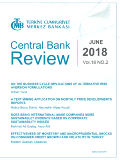
Central Bank Review
Driving insights in economics and financial policy.Central Bank Review is a leading journal published by the CENTRAL BANK REPUBLIC TURKEY, dedicated to advancing the field of economics and finance. With an ISSN of 1303-0701 and an E-ISSN of 1305-8800, this open-access journal has been serving the academic community since 2016, providing a rich source of knowledge for researchers, professionals, and students alike. The journal focuses on a diverse range of topics within economics, econometrics, and finance, making it a valuable resource for those looking to stay at the forefront of these rapidly evolving fields. Notably, in 2023, it achieved a Q2 ranking in both Economics and Econometrics and Finance, highlighting its relevance and impact within the academic community, with Scopus rankings placing it in the top quartile of its categories. Central Bank Review not only contributes to rigorous academic discourse but also offers insights and policy discussions pertinent for central banking and economic policy, solidifying its importance in shaping the future of economic research. Located in the Netherlands, this journal provides easy access to its published articles, ensuring that vital research reaches readers globally.
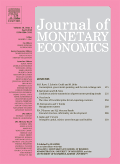
JOURNAL OF MONETARY ECONOMICS
Empowering Scholars in the Realm of FinanceJOURNAL OF MONETARY ECONOMICS, published by Elsevier, stands as a premier platform for scholars and practitioners in the field of monetary economics. With a robust ISSN of 0304-3932 and E-ISSN 1873-1295, this esteemed journal has maintained a significant influence since its inception in 1975, continuing its legacy of rigorous scholarship through to 2024. The journal is recognized for its high impact in the field, boasting a Q1 category in both Economics and Econometrics and Finance as per the 2023 rankings. Its Scopus rankings underscore its prominence, with a top percentile standing in critical categories—a testament to its critical role in advancing research and discourse. While not an open-access publication, it offers invaluable insights for those dedicated to understanding complex fiscal dynamics and economic policies. The Journal of Monetary Economics serves as an essential resource for researchers, professionals, and students eager to explore the intricacies of financial systems and economic theory.
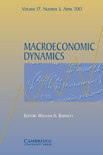
MACROECONOMIC DYNAMICS
Pioneering Research for Informed Economic PoliciesMACROECONOMIC DYNAMICS, a distinguished academic journal published by Cambridge University Press, serves as a pivotal platform for innovative research in the fields of economics and econometrics. With its ISSN 1365-1005 and E-ISSN 1469-8056, the journal has been at the forefront of scholarly communication since its inception in 1997, offering an extensive range of articles that explore dynamic economic models, policy impacts, and theoretical advancements through the latest empirical analyses. Currently holding a Q2 ranking within the 2023 Economics and Econometrics category, and positioned at rank #409 out of 716 within Scopus, it is an essential resource for researchers, professionals, and students alike, looking to stay updated on critical developments in macroeconomic theory and practice. Although it follows a traditional subscription model rather than Open Access, the journal continually strives to disseminate high-quality, peer-reviewed content that informs and inspires the global economics community. The importance of MACROECONOMIC DYNAMICS lies in its commitment to fostering a deeper understanding of economic phenomena, making it a must-read for anyone engaged in the complexities of the economic landscape.
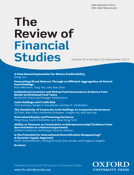
REVIEW OF FINANCIAL STUDIES
Driving Impactful Discoveries in Financial StudiesREVIEW OF FINANCIAL STUDIES, published by Oxford University Press Inc, stands as a premier academic journal in the realms of accounting, economics, and finance. With an impressive Impact Factor that reflects its high citation rates and broad influence, this journal, with an ISSN of 0893-9454 and E-ISSN 1465-7368, is considered a cornerstone for researchers, academics, and professionals seeking to contribute to and stay updated on groundbreaking developments in financial studies. Since its inception in 1996, it has established a robust reputation, consistently ranking in the Q1 category across multiple disciplines, highlighting its elite status in the global academic landscape. The Scopus rankings further reinforce its importance, positioning it at the forefront of business, economics, and finance research. While the journal is not open access, it offers vital insights and comprehensive studies that foster a deeper understanding of contemporary financial issues and methodologies. Located in the United Kingdom, the REVIEW OF FINANCIAL STUDIES is an essential resource for those aiming to advance their knowledge and research in this dynamic field.
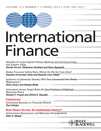
International Finance
Transforming theories into impactful financial practices.International Finance is a prestigious academic journal published by WILEY, dedicated to the exploration and advancement of theories and practices in the realms of finance, development, and geography. With a strong emphasis on empirical and theoretical research, this journal provides a crucial platform for researchers, professionals, and students to disseminate cutting-edge findings that shape our understanding of the financial landscape on a global scale. Holding an impressive impact factor and categorized in the Q2 quartile across multiple disciplines, including Development, Finance, and Geography, the journal has established itself as a significant contributor to scholarly discourse. Since its inception in 1998 and spanning until 2024, International Finance offers a comprehensive overview of current trends and challenges faced in financial contexts, enhancing the decision-making processes within academia and industry alike. Although the journal is not open access, its rigorous peer-review process guarantees high-quality content that is indispensable for anyone engaged in the diverse fields intersecting with finance.
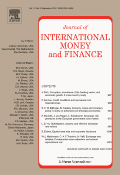
JOURNAL OF INTERNATIONAL MONEY AND FINANCE
Advancing global finance through rigorous research.JOURNAL OF INTERNATIONAL MONEY AND FINANCE is a premier scholarly publication dedicated to advancing the understanding of international finance and monetary economics. Published by Elsevier Science Ltd, this esteemed journal has been disseminating critical research since its inception in 1982 and will continue to contribute to the field through 2024. With a strong international presence and headquarters in the United Kingdom, the journal boasts an impressive collection of articles that explore significant trends, challenges, and innovations in the areas of economics and finance. Recognized for its impact, it ranks in the top quartile (Q1) in both the Economics and Econometrics and Finance categories as of 2023, signifying its influence and relevance among peers. Researchers, professionals, and students in these disciplines can benefit from the journal's rigorous peer-review process, ensuring high-quality scholarly outputs. Though not currently an open-access journal, it provides various subscription options to foster access to groundbreaking research in the financial ecosystem.

FEDERAL RESERVE BANK OF ST LOUIS REVIEW
Illuminating the path to financial stability and growth.The Federal Reserve Bank of St. Louis Review is a prestigious academic journal published by the Federal Reserve Bank of St. Louis, dedicated to disseminating high-quality research in the field of economics and finance. As a respected publication, it holds a significant position in its domain, as evidenced by its placement in the Q2 quartile in the Business and International Management category and ranking 210 out of 443 in Scopus. The journal offers an insightful platform for researchers, professionals, and students alike to engage with cutting-edge analyses and discussions, emphasizing topics relevant to monetary policy, economic trends, and financial stability. Although it operates without an Open Access model, its articles are instrumental for those looking to deepen their understanding of economic dynamics and policy implications in today’s global marketplace. With a commitment to fostering scholarly exchange, the Federal Reserve Bank of St. Louis Review remains a vital resource for advancing knowledge and practical solutions in economics and finance.

American Economic Journal-Macroeconomics
Exploring the Dynamics of Global EconomiesAmerican Economic Journal-Macroeconomics, published by the American Economic Association, stands at the forefront of economic research, addressing pivotal macroeconomic issues that shape global economies. With an impressive Scopus rank of #8 out of 288 in its field and a notable 97th percentile ranking, this journal is widely regarded as a top-tier publication, specifically categorized in the Q1 category for Economics, Econometrics, and Finance as of 2023. Operating under ISSN 1945-7707 and E-ISSN 1945-7715, it aims to disseminate high-quality research from 2009 through 2024 and beyond, providing crucial insights into macroeconomic theory and policy. Although the journal currently does not operate under an open access model, it remains a vital resource for researchers, economists, and students seeking to deepen their understanding of macroeconomic dynamics and their implications for economic policy worldwide. The journal's impactful contributions make it an essential read for those striving to influence economic thought and practice.
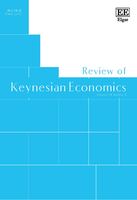
Review of Keynesian Economics
Cultivating Innovative Research in Economic TheoryReview of Keynesian Economics, published by Edward Elgar Publishing Ltd, stands as a pivotal platform for scholarly discourse within the Economics and Econometrics field. With its ISSN 2049-5323 and E-ISSN 2049-5331, the journal has cultivated a robust reputation since its inception in 2012, recently earning recognition as a Q2 journal in its 2023 category rankings. The journal aims to delve into contemporary issues through the lens of Keynesian theory, fostering innovative research and critical analysis that challenges prevailing economic paradigms. Although the journal features no open access options, its rich repository of peer-reviewed articles provides invaluable insights for researchers, professionals, and students alike, making it a staple resource for those keen on exploring the evolving landscape of economic thought. With a Scopus rank of 300/716 in the realm of Economics, this journal occupies a notable position, reflecting its continued relevance and impact within the academic community.